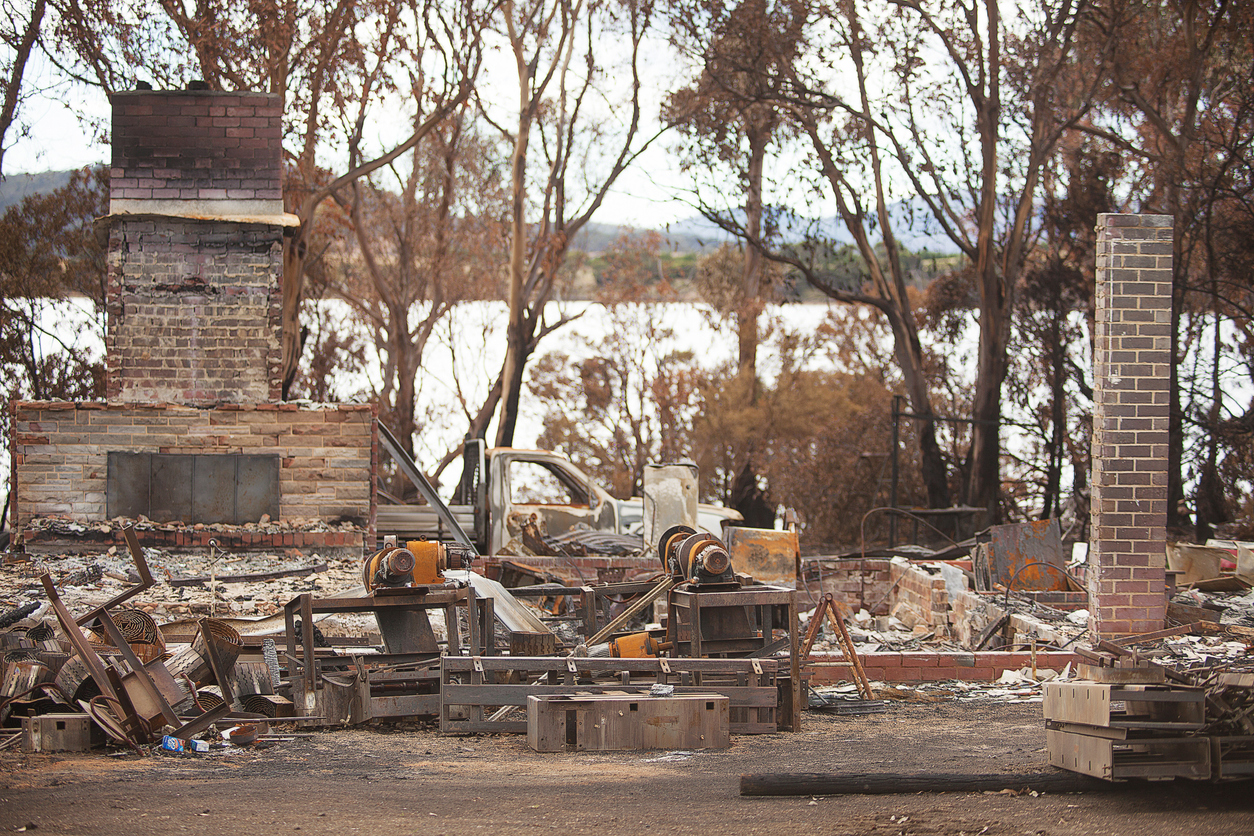
Bushfires are a powerful and potentially devastating occurrence. If you evacuated before the fire, check with your local emergency services that it is safe to return home before doing so.
Clean-up and recovery after a bushfire can be heart-wrenching, traumatic and also dangerous. Dealing with dead and surviving livestock, trying to retrieve belongings from fire-damaged buildings, dealing with hazardous materials, and repairing burnt fences, are all physically and emotionally difficult work. It is important to be cautious and take time to protect your health, wellbeing, and safety.
The Department of Energy, Environment and Climate Action (DEECA), local veterinarians and your local council can coordinate and provide recovery assistance and advice to primary producers impacted by a natural disaster event.
Key considerations
Livestock welfare: Assistance can be provided to assess and evaluate your stock damage and help with the disposal of animals that need to be destroyed.
Hazardous materials that may be present after a bushfire include:
- Ash, especially from burnt treated timber (fenceposts and yards).
- Dust, especially if it contains asbestos.
- Farm, garden and household chemicals.
- Spoiled milk after power cuts.
- Metal and plastic residues from burnt appliances or tools.
- Live electricity cables.
- Damaged gas and fuel storages and distribution equipment.
Wear protective clothing to check your property after a bushfire. This should include:
- Heavy duty work gloves and sturdy shoes.
- Long sleeve shirt and trousers or disposable overalls.
- P2/N95 face mask.
- Hat for sun protection.
Clean or dispose of personal protective equipment (PPE) when leaving the property. Wash hands after carefully removing PPE.
Drinking water storages may be contaminated by ash, debris or fire-retardant chemicals. Do not drink water that tastes, looks or smells unusual. Do not give it to livestock or use in evaporative coolers. Disconnect rainwater tanks from roof gutter and downpipes prior to first rain (if possible) to avoid further contamination. Clean or drain sludge from tanks, but do not enter the tank due to the danger of working in a confined space – use professional tank cleaning services. For more information on making tanks and drinking water safe refer to our fact sheet: Water – make it safe to drink.
For more information on bushfire support and information visit the DEECA Bushfire Recovery webpage or for more safety tips on bushfire aftermath visit Better Health Channel.
For important information on returning home after a bushfire, visit your relevant local, regional or state emergency websites.
Personal social and emotional wellbeing
In the immediate aftermath of a bushfire, it is normal for people to experience intense stress reactions. Most people recover without professional intervention within several months and maintain a healthy level of functioning over time.
Typical responses to trauma experienced during and following disasters like bushfire include:
- Emotional responses such as shock, fear, anger, helplessness, irritability, depression, sadness, shame, guilt, lower life satisfaction.
- Biological responses such as fatigue, exhaustion, headaches, general aches and pains.
- Psychological responses such as tension, inability to make decisions, emotional distress, states of high arousal, reliving the events in flashbacks or nightmares, irritability.
- Behavioural responses such as avoidance of reminders or triggers, increased time spent at work, use of alcohol and drugs.
- Social responses such as intolerance of others, social withdrawal, breakdown of relationships, social networks and sense of community.
For more suggestions check out the information sheet on Recovering from Bushfires which outlines some useful skills that will help you recover. Strategies include restoring helpful thinking patterns and problem-solving capacity, maintaining social connection, taking time for pleasurable activities and learning to manage emotional distress. All of these skills will assist you to navigate your family, community and farm business through a tough period following the bushfire.
Some people who are impacted by bushfires may experience mental health disorders in the months or even years after the initial event. The impact of multiple disasters in close succession can be cumulative in its effect on an individual.
Common mental health disorders following a natural disaster such as bushfire may include:
- Depression – sad or depressed mood, loss of interest in normal activities, poor motivation and lack of energy, disturbed sleep, poor appetite and in more severe cases, suicidal thoughts.
- Anxiety – fear that something bad will happen, and worry about safety, health and money; physical symptoms can include being tense, on edge, a racing heart, and social withdrawal.
- Substance use disorders – excessive use of alcohol or other drugs, which interferes with the person’s social relationships and ability to carry out normal roles.
- Post-traumatic stress disorder – memories haunt the person (high arousal, being on edge, disturbed sleep, irritability) and efforts to avoid triggers, and numbing of emotional responsiveness.
Individuals experiencing any of these mental health conditions in the months and years following the natural disaster will benefit from effective treatments which are readily accessible through mental health professionals. Farmers are especially encouraged to seek help if they find themselves struggling in any of these ways.
If you feel you or someone else needs help, go to our Support Hub to access support contacts.
Fast facts:
- Cleaning up after a bushfire can be traumatic, difficult and dangerous.
- Stay clear of fallen power lines, they could be live.
- Be aware of potential hazards like farm chemicals or asbestos.
- Seek professional help to assess livestock.
- Consider seeking support for yourself or others.
References used for this topic
More information:
Better Health Channel
Bushfire aftermath – safety tips
Department of Energy, Environment and Climate Action (VIC)
Emergency and Bushfire Recovery Program
Vic Emergency
Recovering from a bushfire
Better Health Channel
Post-traumatic stress disorder (PTSD)
Australian Disaster Resilience Knowledge Hub
Community Recovery Handbook
Australian Psychological Society
Recovery from bushfires
|
|